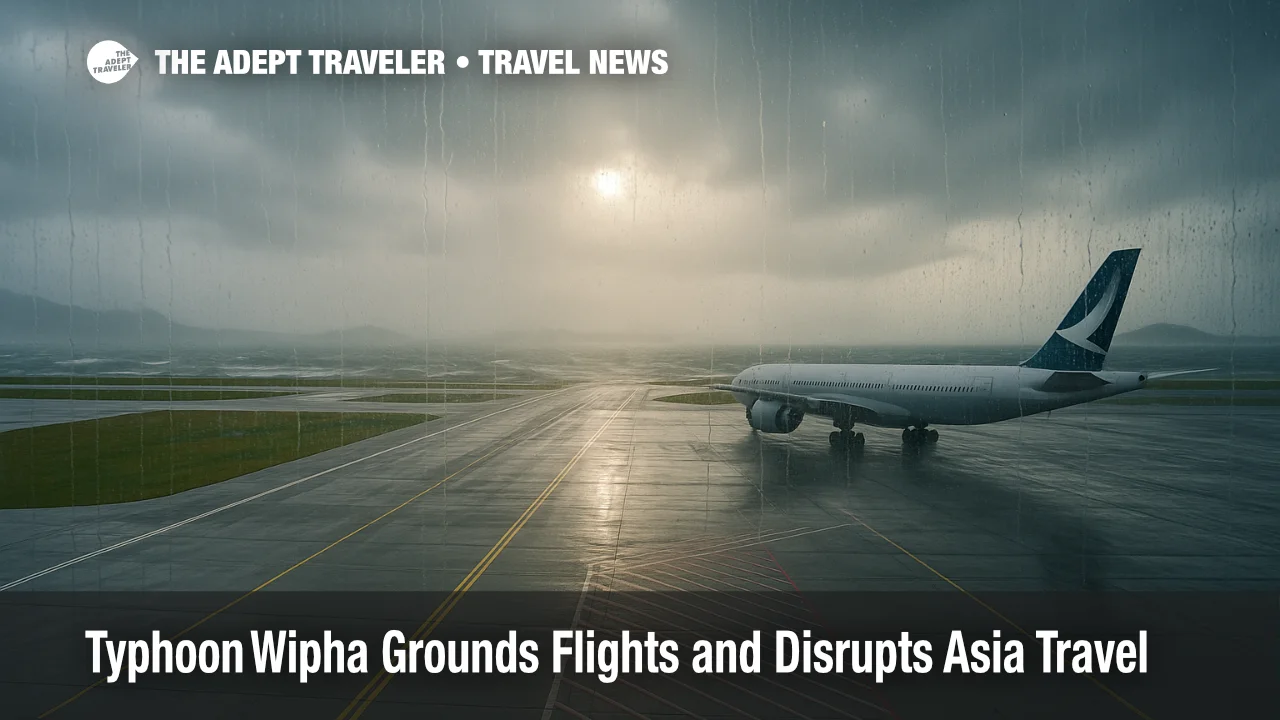Typhoon Wipha Grounds Flights and Disrupts Asia Travel

Typhoon Wipha swept past Hong Kong on July 20, 2025, forcing the city to raise its highest storm warning, grounding more than 400 flights, and halting nearly all ferries. Although the signal has since been lowered, gale-force gusts, heavy rain, and rough seas continue to ripple across the Pearl River Delta, complicating onward travel into Guangdong and Macau. Carriers are waiving change fees, airports are rationing runway slots, and rail operators are running reduced timetables. With the system forecast to track west toward northern Vietnam by Monday night, travelers across the region should brace for rolling delays and localized flooding.
Key Points
- Signal No. 10 dropped to No. 3, but squalls persist.
- Cathay Pacific canceled all Hong Kong flights until 6 p.m. Sunday.
- Ferries, trams, and some rail links remain suspended or limited.
- Hong Kong International Airport activated its Emergency Centre.
- Why it matters: 80,000 travelers face cascading schedule changes.
Snapshot
Typhoon Wipha-catalogued by the Japan Meteorological Agency as T2506-intensified from a severe tropical storm to a typhoon just east of Hong Kong late Saturday. At peak, sustained winds near the center reached 87 mph with gusts past 105 mph, generating 20-foot seas and torrential rainfall bands. The compact core passed roughly 35 miles south-southwest of Hong Kong International Airport (HKG) at midday Sunday before making landfall near Taishan, Guangdong. Forecasters expect steady weakening as the system tracks west over land, yet its broad rain shield and onshore flow continue to feed coastal storm surge and mountain run-off.
Background
Wipha is the season's sixth named cyclone in the western North Pacific and the first significant system to target Hong Kong since Super-Typhoon Saola in 2024. It originated as a monsoon-trough disturbance east of the Philippines on July 15, absorbing tropical moisture that earlier fueled heavy rains over Luzon. Filipino authorities named the system Tropical Storm Crising locally; our earlier coverage tracked its west-northwest march toward the South China Sea. Once over open water, warm sea-surface temperatures and low vertical shear allowed rapid intensification before proximity to land caused eventual weakening.
Latest Developments
Flight Operations
- Hong Kong International Airport (HKG): More than 400 flights were canceled or retimed Sunday. The Flight Rescheduling Control System is allocating departure slots as winds ease, but residual delays of 6-12 hours are likely through Monday morning.
- Airlines: Cathay Pacific, Hong Kong Airlines, China Southern, and HK Express issued fee-waiver policies for tickets dated July 20-21. In-terminal rest areas with power banks, bottled water, and blankets remain open overnight.
Ground & Sea Transport
- Ferries to Macau, Lantau, and outlying islands are suspended until sea states fall below the eight-foot threshold. The MTR Airport Express is running a 30-minute headway instead of its usual 10 minutes; other urban lines operate at 75 percent frequency. Cross-border buses along the Hong Kong-Zhuhai-Macau Bridge remain halted.
Forward Track & Forecast
- The Hong Kong Observatory downgraded warnings to the Strong Wind Signal No. 3 at 9 p.m. Sunday, but localized squalls may prompt brief upgrades. The storm is projected to weaken to a tropical depression near the Gulf of Tonkin late Monday, yet flash-flood risk persists in Guangxi and northern Vietnam. Coastal Vietnam could experience 4-6 inches of rain and wind gusts near 50 mph. Flight and ferry operators in Hanoi, Haiphong, and Da Nang have issued precautionary delay notices.
Analysis
Travelers should expect a multi-day ripple effect. Airlines will need aircraft, crew, and gate re-sequencing, which often creates rolling cancellations on secondary routes. Flexibility-either shifting departure airports within the Greater Bay Area or rerouting via Bangkok, Seoul, or Taipei-can shorten disruptions. Travelers already holding non-refundable hotel bookings in Hong Kong should contact properties; many waive first-night penalties when local No. 8 or higher signals are in force. Cruise lines home-ported at Kai Tak are adjusting itineraries, typically substituting a sea day for Hong Kong and reversing port order. Rail pass holders on China Rail high-speed services must re-reserve seats once bullet-train schedules normalize, usually 24 hours after a typhoon warning drops below No. 3. Comprehensive travel insurance that covers "weather and natural disaster" interruptions remains the most effective safeguard against unexpected expenses.
Final Thoughts
Typhoon Wipha's sharp but disruptive swipe underscores why July's Western Pacific typhoon peak demands vigilant planning. Recheck flight status every few hours, budget extra transit time between airport and city, and follow official advisories rather than social media rumors. If your itinerary is flexible, consider pushing departures back two full days to allow airline and rail networks to reset. Above all, monitor updated bulletins until the system clears Vietnam, as lingering bands can still spawn flash floods far from the coast. Staying informed and adaptable will help you avoid the worst fallout from Typhoon Wipha travel impact.
